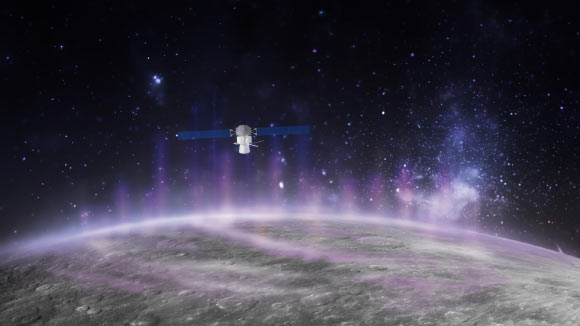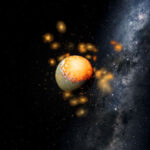An analysis of data obtained during the ESA/JAXA BepiColombo spacecraft’s first Mercury flyby reveals that Mercury’s southern magnetosphere aurorae are similar to those seen on Earth and Mars.
An artist’s representation of BepiColombo flying through precipitating electrons that can trigger X-ray auroras on the surface of Mercury. Image credit: Thibaut Roger / Europlanet.
Terrestrial auroras are generated by interactions between the solar wind, a stream of charged particles emitted by the Sun, and an electrically charged upper layer of Earth’s atmosphere, called the ionosphere.
As Mercury only has a very thin atmosphere, called an exosphere, its auroras are generated by the solar wind interacting directly with the planet’s surface.
“For the first time, we have witnessed how electrons are accelerated in Mercury’s magnetosphere and precipitated onto the planet’s surface,” said Dr. Sae Aizawa, a planetary researcher at the Institut de Recherche en Astrophysique et Planétologie, JAXA’s Institute of Space and Astronautical Science and the University of Pisa.
“While Mercury’s magnetosphere is much smaller than Earth’s and has a different structure and dynamics, we have confirmation that the mechanism that generates aurorae is the same throughout the Solar System.”
In their study, Dr. Aizawa and colleagues analyzed simultaneous measurements of low-energy electrons (less than 30 kiloelectron volts) and ions during the BepiColombo mission’s first flyby of Mercury in October 2021.
“During the flyby, BepiColombo approached Mercury from the night side of the northern hemisphere and made its closest approach near the morning side of the southern hemisphere,” they explained.
“It observed the magnetosphere on the daytime side of the southern hemisphere, and then passed out of the magnetosphere back into the solar wind.”
“Its instruments successfully observed the structure and the boundaries of the magnetosphere, including the magnetopause and bow shock.”
“The data also showed that the magnetosphere was in an unusually compressed state, most likely due to high pressure conditions in the solar wind.”
The authors found direct evidence that energetic electrons are accelerated in the near-tail region of Mercury’s magnetosphere, drift rapidly toward the dayside, and are subsequently injected onto closed magnetic field lines on the planetary nightside. This process is observed as X-ray aurorae.
“Despite differences in the structure and dynamics of the planetary magnetospheres, electron injections and subsequent energy-dependent drift are a universal mechanism observed throughout our Solar System,” they said.
The findings were published in the journal Nature Communications.
_____
S. Aizawa et al. 2023. Direct evidence of substorm-related impulsive injections of electrons at Mercury. Nat Commun 14, 4019; doi: 10.1038/s41467-023-39565-4




